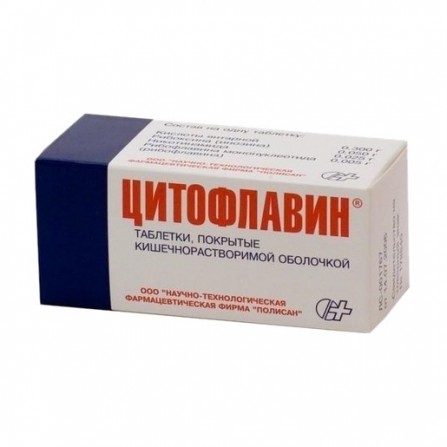More info
Active ingredients
Inosine + Nicotinamide + Riboflavin + Succinic Acid
Release form
Pills
Composition
Ingredients 1 tablet contains: active substances: succinic acid - 0.3 g, riboxin (inosine) - 0.05 g, nicotinamide - 0.025 g, riboflavin mononucleotide (riboflavin) - 0.005 g, excipients: medium molecular weight polyvinylpyrrolidone (povidone), calcium stearate, copolymer of methacrylic acid and ethyl acrylate, 1,2-propylene glycol, acid red 2С, Tropeolin O.
Pharmacological effect
Metabolic drug. Pharmacological effects due to the complex effect of the components that make up the drug Cytoflavin. Succinic acid is an endogenous intracellular metabolite of the Krebs cycle, which performs a universal energy-synthesizing function in the cells of the body. With the participation of the coenzyme flavinadenedinucleotide (FAD), succinic acid, a mitochondrial enzyme succinate dehydrogenase, is rapidly transformed into fumaric acid and further into other metabolites of the tricarboxylic acid cycle. Stimulates aerobic glycolysis and ATP synthesis in cells. The final product of the metabolism of succinic acid in the Krebs cycle is carbon dioxide and water. Succinic acid improves tissue respiration due to the activation of electron transport in mitochondria. Inosine is a derivative of purine, the precursor of ATP. It has the ability to activate a number of Krebs cycle enzymes, stimulating the synthesis of key enzymes-nucleotides - FAD and NAD. Nicotinamide (vitamin PP), nicotinic acid amide. Nicotinamide in cells, through a cascade of biochemical reactions, is transformed into the form of nicotinamide adenine nucleotide (NAD) and its phosphate (NADP), activating the nicotinamide-dependent enzymes of the Krebs cycle, necessary for cellular respiration and stimulation of ATP synthesis. Riboflavin (vitamin B2) is a flavin coenzyme (FAD) that activates succinate dehydrogenase and other redox reactions of the Krebs cycle. Thus, all components of the drug Cytoflavin are natural metabolites of the body and stimulate tissue respiration. Metabolic energy correction, antihypoxic and antioxidant activity of the drug, determining the pharmacological properties and therapeutic effectiveness of the components, due to the complementary effect of succinic acid, inosine, nicotinamide and riboflavin.
Pharmacokinetics
Cytoflavin has a high bioavailability.When administered orally, succinic acid is absorbed from the gastrointestinal tract, enters the blood and tissues, participating in energy metabolism reactions, and completely decomposes to the final products of metabolism (carbon dioxide and water) after 30 minutes. Inosine is well absorbed from the gastrointestinal tract. Tmax in the blood is 5 h, the average retention time in the blood is 5.5 h, Vd in the equilibrium state is about 20 l. Inosine is metabolized in the liver to form inosine monophosphate, followed by its oxidation to uric acid. In small quantities excreted by the kidneys. Nicotinamide is rapidly distributed in all tissues (Vd in the equilibrium state - about 500 liters). Tmax in the blood is 2 hours, the average retention time in the blood is 4.5 hours. Metabolized in the liver to form N-methylnicotinamide. Excreted by the kidneys. Nicotinamide penetrates the placental barrier. Penetrates into breast milk. Riboflavin is rapidly absorbed from the gastrointestinal tract, is unevenly distributed (the largest number in the myocardium, liver, kidneys), transformed into flavinadenine mononucleotide (FMN) and FAD in mitochondria. It penetrates the placental barrier. It is excreted in breast milk. Excreted by the kidneys, mainly in the form of metabolites.
Indications
In adults in complex therapy: 1. Acute cerebrovascular accident. 2. Consequences of cerebrovascular diseases (consequences of cerebral infarction, cerebral atherosclerosis). 3. Toxic and hypoxic encephalopathy in acute and chronic poisoning, endotoxicosis, post-anesthetic depression of consciousness, as well as for the prevention and treatment of hypoxic encephalopathy during cardiac surgery using cardiopulmonary bypass.
Contraindications
Hypersensitivity in patients on mechanical ventilation with a decrease in the partial pressure of oxygen in arterial blood of less than 60 mm Hg. Art., breastfeeding period. Nephrolithiasis, gout, hyperuricemia.
Precautionary measures
From the side of the central nervous system: perhaps - a headache. On the part of the digestive system: possibly - pain or discomfort in the epigastric region. On the part of metabolism: perhaps - transient hypoglycemia, hyperuricemia, exacerbation of concomitant gout.
Use during pregnancy and lactation
It is not recommended to use Cytoflavin during pregnancy and lactation, due to the lack of clinical data on the efficacy and safety of the drug in this category of patients.
Dosage and administration
Inside 2 pills 2 times a day with an interval of 8-10 hours between doses.Tablets should be taken at least 30 minutes before a meal, without chewing, drinking water (100 ml). The drug is recommended in the morning and daytime (no later than 18 hours). Duration of treatment is 25 days. Appointment of re-rate is possible with an interval of at least 1 month.
Side effects
Headache, pain or discomfort in the epigastric region. Allergic reactions are possible in the hyperemia and itching. Adverse reactions include transient hypoglycemia, hyperuricemia, exacerbation of concomitant gout. If any of the side effects indicated in the instructions are exacerbated or you notice any other side effects not listed in the instructions, tell your doctor.
Overdose
To date, no cases of an overdose of the drug Cytoflavin have been established.
Interaction with other drugs
Succinic acid, inosine and nicotinamide, which are part of the preparation Cytoflavin, are compatible with other drugs. Riboflavin, which is part of the drug Cytoflavin, reduces the activity of some antibiotics (tetracyclines, erythromycin, lincomycin), is incompatible with streptomycin. Ethanol, tricyclic antidepressants, tubular secretion blockers reduce riboflavin absorption, and thyroid hormones accelerate its metabolism.
special instructions
In hypertension, dose adjustment of antihypertensive drugs may be required. In patients with diabetes mellitus, treatment should be carried out under the control of the concentration of glucose in the blood. During the period of treatment, intense staining of urine may be yellow. Influence on the ability to drive vehicles and control mechanisms Cytoflavin does not affect the ability to drive vehicles, to work with moving mechanisms; to work dispatchers and operators.






